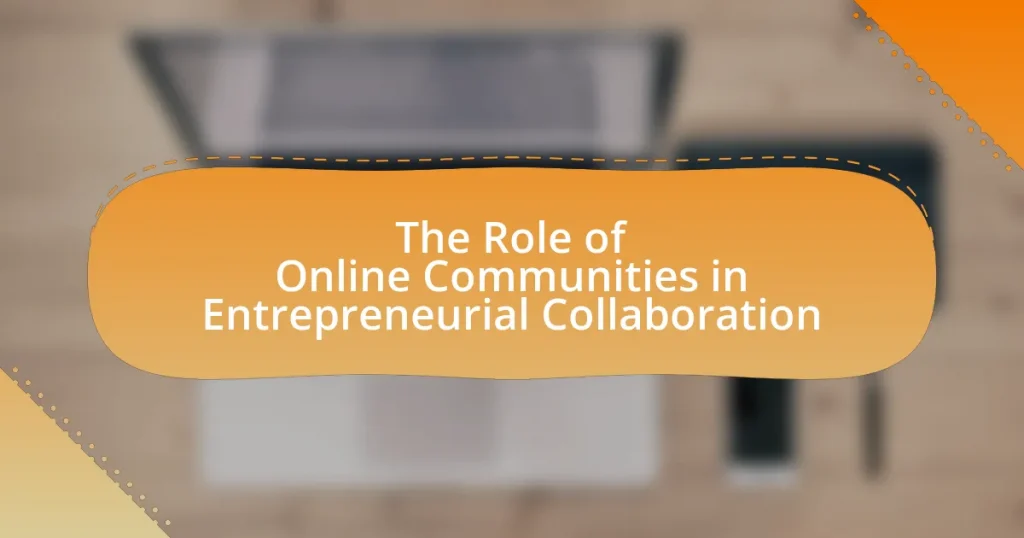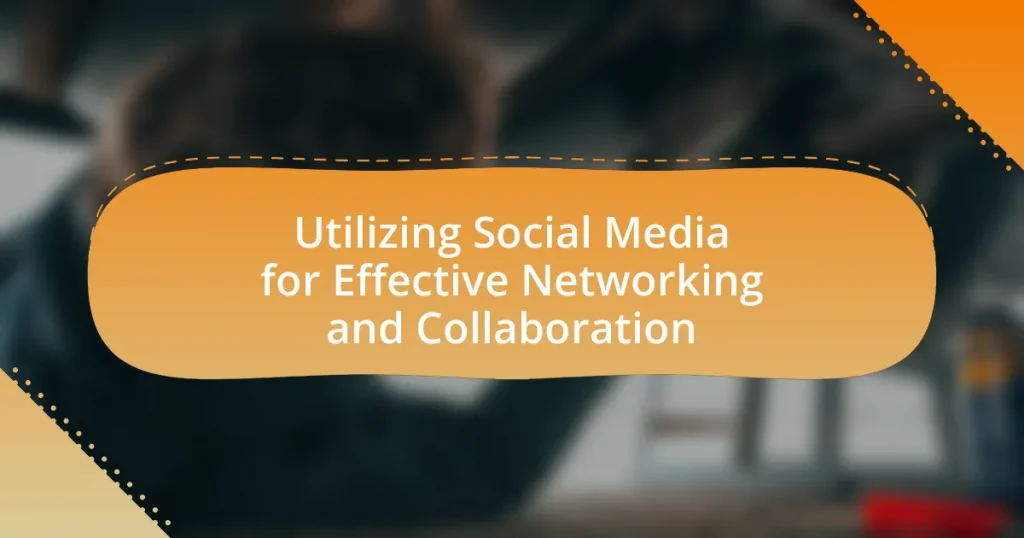Effective communication techniques for entrepreneurs are essential for building relationships, conveying ideas, and driving business success. Key components include active listening, clear messaging, and adaptability, which enhance collaboration and productivity. Research indicates that effective communication can lead to significant improvements in team performance and customer satisfaction. The article explores the importance of communication in entrepreneurship, the skills necessary for effective interactions, and strategies to overcome common communication challenges, ultimately highlighting best practices for fostering a positive and productive business environment.

What are Effective Communication Techniques for Entrepreneurs?
Effective communication techniques for entrepreneurs include active listening, clear messaging, and adaptability. Active listening involves fully concentrating on the speaker, which fosters trust and understanding, essential for effective collaboration. Clear messaging ensures that ideas are conveyed succinctly and without ambiguity, reducing the risk of misinterpretation. Adaptability allows entrepreneurs to adjust their communication style based on the audience, enhancing engagement and receptiveness. Research indicates that effective communication can lead to a 25% increase in productivity and a 50% improvement in team collaboration, highlighting its critical role in entrepreneurial success.
Why is effective communication crucial for entrepreneurs?
Effective communication is crucial for entrepreneurs because it directly impacts their ability to build relationships, convey ideas, and drive business success. Entrepreneurs must articulate their vision clearly to attract investors, motivate employees, and engage customers. Research indicates that effective communication can enhance team collaboration and increase productivity by up to 25%, as noted in a study by the McKinsey Global Institute. This demonstrates that strong communication skills not only foster a positive work environment but also contribute to achieving business objectives.
How does communication impact business success?
Effective communication significantly impacts business success by enhancing collaboration, improving employee engagement, and fostering customer relationships. Clear communication ensures that team members understand their roles and responsibilities, which leads to increased productivity. According to a study by the Project Management Institute, organizations with effective communication practices are 50% more likely to have projects completed on time and within budget. Furthermore, effective communication with customers builds trust and loyalty, which is crucial for long-term business growth. A report from Salesforce indicates that 70% of customers say connected processes are very important to winning their business, highlighting the role of communication in customer satisfaction and retention.
What role does communication play in team dynamics?
Communication is essential in team dynamics as it facilitates collaboration, enhances understanding, and fosters trust among team members. Effective communication ensures that all members are aligned with the team’s goals and objectives, which is crucial for achieving high performance. Research indicates that teams with strong communication practices are 25% more productive than those with poor communication (Harvard Business Review, “The Impact of Communication on Team Performance,” 2017). This demonstrates that clear and open communication not only improves efficiency but also contributes to a positive team culture, ultimately leading to better outcomes.
What are the key components of effective communication?
The key components of effective communication are clarity, active listening, empathy, and feedback. Clarity ensures that the message is easily understood, reducing the chances of misinterpretation. Active listening involves fully concentrating on the speaker, which fosters better understanding and engagement. Empathy allows communicators to connect emotionally, enhancing relationships and trust. Feedback provides a mechanism for confirming understanding and improving future interactions. Research indicates that effective communication can lead to a 25% increase in team performance, highlighting its importance in professional settings.
What skills are essential for effective communication?
Essential skills for effective communication include active listening, clarity, empathy, and nonverbal communication. Active listening enables individuals to fully understand the speaker’s message, fostering better dialogue. Clarity ensures that the message is conveyed in a straightforward manner, reducing misunderstandings. Empathy allows communicators to connect with others’ feelings and perspectives, enhancing relational dynamics. Nonverbal communication, such as body language and facial expressions, reinforces verbal messages and can convey emotions effectively. Research indicates that effective communication skills can lead to improved team collaboration and increased productivity in business settings.
How can entrepreneurs develop these communication skills?
Entrepreneurs can develop communication skills through targeted practice and feedback. Engaging in public speaking opportunities, such as Toastmasters, enhances verbal communication and boosts confidence. Additionally, participating in workshops focused on active listening and non-verbal communication can improve interpersonal skills. Research indicates that entrepreneurs who actively seek feedback from peers and mentors can identify areas for improvement, leading to more effective communication. For instance, a study published in the Journal of Business Communication highlights that entrepreneurs who engage in regular feedback loops significantly enhance their communication effectiveness over time.
What types of communication techniques can entrepreneurs use?
Entrepreneurs can use various communication techniques, including active listening, clear and concise messaging, non-verbal communication, and storytelling. Active listening allows entrepreneurs to fully understand their audience’s needs and feedback, fostering better relationships. Clear and concise messaging ensures that information is easily understood, which is crucial in business settings where time is limited. Non-verbal communication, such as body language and facial expressions, can enhance the message being conveyed and build trust. Storytelling is an effective technique for engaging audiences and making complex ideas relatable, as evidenced by research from the Harvard Business Review, which highlights that stories can significantly improve retention and understanding of information.
What are verbal communication techniques?
Verbal communication techniques are methods used to convey messages effectively through spoken language. These techniques include active listening, clear articulation, appropriate tone and volume, and the use of open-ended questions. Active listening ensures that the speaker feels heard and understood, while clear articulation helps in conveying ideas without ambiguity. The appropriate tone and volume can influence the emotional impact of the message, and open-ended questions encourage dialogue and deeper engagement. Research indicates that effective verbal communication can enhance relationships and improve collaboration in business settings, making it essential for entrepreneurs to master these techniques.
How can non-verbal communication enhance messages?
Non-verbal communication enhances messages by conveying emotions and intentions that words alone may not express. For instance, body language, facial expressions, and gestures can reinforce or contradict verbal messages, providing clarity and depth to communication. Research indicates that approximately 93% of communication effectiveness is determined by non-verbal cues, with 55% attributed to body language and 38% to tone of voice (Mehrabian, 1971). This demonstrates that non-verbal elements play a crucial role in ensuring that the intended message is accurately received and understood, making it essential for entrepreneurs to master these techniques for effective communication.
What role does written communication play in entrepreneurship?
Written communication is essential in entrepreneurship as it facilitates clear and effective information exchange among stakeholders. Entrepreneurs rely on written communication for crafting business plans, marketing materials, and legal documents, which are crucial for securing funding and establishing partnerships. For instance, a study by the Harvard Business Review highlights that effective written communication can increase the likelihood of securing investor interest by 30%. This underscores the importance of clarity and professionalism in written correspondence, which can significantly impact business success.
How can entrepreneurs adapt their communication style?
Entrepreneurs can adapt their communication style by actively assessing their audience’s preferences and adjusting their tone, language, and delivery accordingly. This involves recognizing whether the audience prefers formal or informal communication, understanding cultural nuances, and being aware of the context in which the communication occurs. Research indicates that effective communicators often tailor their messages to fit the needs and expectations of their audience, which enhances engagement and understanding. For instance, a study published in the Journal of Business Communication found that adapting communication styles to match the audience’s characteristics significantly improves message reception and effectiveness.
What factors should influence an entrepreneur’s communication style?
An entrepreneur’s communication style should be influenced by their audience, the context of the communication, and the medium used. Understanding the audience allows entrepreneurs to tailor their language, tone, and complexity to ensure clarity and engagement. For instance, communicating with investors may require a more formal and data-driven approach, while discussions with team members can be more casual and collaborative. The context, such as whether the communication is in a high-stakes meeting or a casual brainstorming session, also dictates the level of formality and assertiveness needed. Additionally, the medium—whether face-to-face, email, or social media—affects how messages are crafted; for example, brevity is crucial in emails, while face-to-face interactions allow for more nuanced expressions. These factors collectively enhance the effectiveness of communication, fostering better relationships and achieving desired outcomes.
How can understanding the audience improve communication effectiveness?
Understanding the audience enhances communication effectiveness by allowing the speaker to tailor their message to the specific needs, preferences, and expectations of the audience. When entrepreneurs grasp the demographics, interests, and pain points of their audience, they can craft messages that resonate more deeply, leading to increased engagement and comprehension. Research indicates that messages aligned with audience values are 50% more likely to be remembered and acted upon, demonstrating the critical role of audience understanding in effective communication.

What challenges do entrepreneurs face in communication?
Entrepreneurs face several challenges in communication, including clarity, audience engagement, and feedback reception. Clarity is often compromised due to complex ideas or jargon, making it difficult for stakeholders to understand the message. Audience engagement can be challenging as entrepreneurs must tailor their communication style to diverse groups, such as investors, employees, and customers, each with different expectations and levels of understanding. Additionally, receiving and interpreting feedback can be problematic; entrepreneurs may struggle to discern constructive criticism from negative comments, which can hinder their decision-making process. These challenges are supported by research indicating that effective communication is crucial for business success, with studies showing that poor communication can lead to misunderstandings and decreased productivity.
What common barriers to effective communication exist?
Common barriers to effective communication include language differences, cultural misunderstandings, emotional barriers, and physical distractions. Language differences can lead to misinterpretations, as individuals may not fully grasp the intended message. Cultural misunderstandings arise when individuals interpret messages through their own cultural lens, potentially leading to offense or confusion. Emotional barriers, such as stress or anger, can hinder the ability to communicate clearly and listen effectively. Physical distractions, including noise or interruptions, can disrupt the flow of communication and prevent messages from being conveyed accurately. These barriers are well-documented in communication studies, highlighting their impact on interpersonal interactions and organizational effectiveness.
How can cultural differences affect communication?
Cultural differences can significantly affect communication by influencing language use, non-verbal cues, and contextual understanding. For instance, in high-context cultures, such as Japan, communication relies heavily on implicit messages and non-verbal signals, while low-context cultures, like the United States, prioritize explicit verbal communication. This disparity can lead to misunderstandings; a study by Hall (1976) highlights that individuals from high-context cultures may perceive directness as rudeness, whereas those from low-context cultures may view indirectness as evasive. Additionally, variations in cultural norms regarding eye contact, gestures, and personal space can further complicate interactions, as demonstrated by research from Gudykunst and Kim (2003), which emphasizes that misinterpretations of these non-verbal signals can hinder effective communication.
What are the impacts of technology on communication challenges?
Technology significantly alters communication challenges by introducing both advantages and obstacles. On one hand, technology enhances communication speed and accessibility, allowing entrepreneurs to connect with clients and teams globally through platforms like email, video conferencing, and instant messaging. For instance, a study by the Pew Research Center found that 90% of adults use the internet, facilitating instant communication across distances.
Conversely, technology can create barriers such as miscommunication due to lack of non-verbal cues, information overload, and reliance on digital mediums that may lead to misunderstandings. Research from the Journal of Business Communication indicates that 70% of employees feel overwhelmed by the volume of emails they receive, which can hinder effective communication.
Thus, while technology provides tools that can improve communication efficiency, it also presents challenges that require careful management to ensure clarity and understanding in entrepreneurial contexts.
How can entrepreneurs overcome communication challenges?
Entrepreneurs can overcome communication challenges by actively listening, utilizing clear and concise messaging, and leveraging technology for better collaboration. Active listening ensures that entrepreneurs fully understand their team’s perspectives, which fosters a more inclusive environment. Clear and concise messaging helps to eliminate misunderstandings, as studies show that effective communication can increase team productivity by up to 25%. Additionally, using technology tools like project management software and communication platforms enhances collaboration, allowing for real-time feedback and reducing the likelihood of miscommunication.
What strategies can be employed to enhance clarity?
To enhance clarity, entrepreneurs can employ strategies such as simplifying language, structuring information logically, and using visual aids. Simplifying language involves avoiding jargon and complex terms, which can confuse the audience; research indicates that clear language increases understanding by up to 80%. Structuring information logically, such as using bullet points or numbered lists, helps the audience follow the message more easily. Additionally, incorporating visual aids like charts or infographics can reinforce verbal communication, as studies show that visuals can improve retention of information by 65%. These strategies collectively improve the effectiveness of communication in entrepreneurial contexts.
How can feedback be used to improve communication?
Feedback can be used to improve communication by providing specific insights into how messages are received and understood. When individuals receive constructive feedback, they can identify areas for clarification, adjust their messaging strategies, and enhance their overall communication effectiveness. Research indicates that organizations that actively solicit and implement feedback experience a 14.9% increase in productivity, demonstrating the tangible benefits of feedback in refining communication practices.

What are best practices for effective communication in entrepreneurship?
Best practices for effective communication in entrepreneurship include clarity, active listening, and adaptability. Clarity ensures that messages are easily understood, reducing the risk of misinterpretation; for instance, using straightforward language and avoiding jargon can enhance comprehension among diverse audiences. Active listening fosters engagement and builds trust, as it demonstrates respect for others’ perspectives and encourages open dialogue. Adaptability allows entrepreneurs to tailor their communication style to different stakeholders, whether they are investors, employees, or customers, enhancing the effectiveness of the interaction. Research by the Harvard Business Review indicates that effective communication can lead to a 25% increase in team performance, underscoring the importance of these practices in achieving entrepreneurial success.
How can entrepreneurs implement active listening techniques?
Entrepreneurs can implement active listening techniques by focusing on fully engaging with the speaker, demonstrating attentiveness through verbal and non-verbal cues, and providing feedback that reflects understanding. Engaging with the speaker involves maintaining eye contact, nodding, and using affirming phrases, which encourages open communication. Additionally, summarizing or paraphrasing what the speaker has said confirms comprehension and shows that their input is valued. Research indicates that effective listening can enhance team collaboration and improve decision-making, as highlighted in studies by the Harvard Business Review, which emphasize that leaders who practice active listening foster a more inclusive and productive work environment.
What are the benefits of active listening in business?
Active listening in business enhances communication, fosters trust, and improves problem-solving. By fully engaging with speakers, employees feel valued, leading to increased morale and collaboration. Research indicates that organizations with strong communication practices are 25% more productive. Furthermore, active listening helps in accurately understanding client needs, which can boost customer satisfaction and retention rates. This technique also minimizes misunderstandings, reducing conflict and promoting a more harmonious workplace environment.
How can entrepreneurs practice active listening in meetings?
Entrepreneurs can practice active listening in meetings by fully engaging with the speaker, maintaining eye contact, and providing verbal affirmations. This approach ensures that the speaker feels heard and valued, which fosters a more open dialogue. Research indicates that active listening enhances understanding and retention of information, leading to more effective decision-making. For instance, a study published in the Journal of Business Communication found that active listening significantly improves team collaboration and reduces misunderstandings, thereby increasing overall productivity in meetings.
What role does empathy play in communication?
Empathy plays a crucial role in communication by fostering understanding and connection between individuals. When communicators demonstrate empathy, they are better able to interpret emotions, respond appropriately, and build trust, which enhances the overall effectiveness of the interaction. Research indicates that empathetic communication leads to improved relationships and collaboration, as it allows individuals to feel heard and valued. For instance, a study published in the Journal of Business Communication found that leaders who practiced empathy were more successful in motivating their teams and achieving organizational goals. This evidence underscores the importance of empathy as a fundamental component of effective communication, particularly for entrepreneurs seeking to engage and inspire their stakeholders.
How can showing empathy improve relationships with stakeholders?
Showing empathy can significantly improve relationships with stakeholders by fostering trust and open communication. When stakeholders feel understood and valued, they are more likely to engage positively and collaborate effectively. Research indicates that organizations that prioritize empathetic communication experience higher levels of stakeholder satisfaction and loyalty, as evidenced by a study published in the Journal of Business Ethics, which found that empathetic leadership correlates with increased employee engagement and stakeholder trust. This trust leads to stronger partnerships and more successful outcomes for all parties involved.
What techniques can entrepreneurs use to demonstrate empathy?
Entrepreneurs can demonstrate empathy by actively listening to their team members and customers. Active listening involves giving full attention, acknowledging feelings, and responding thoughtfully, which fosters a deeper understanding of others’ perspectives. Research indicates that effective listening can enhance workplace relationships and improve team dynamics, as shown in a study by the Harvard Business Review, which found that leaders who practice active listening are perceived as more empathetic and trustworthy. Additionally, entrepreneurs can use open-ended questions to encourage dialogue, allowing individuals to express their thoughts and emotions freely. This technique not only validates others’ experiences but also builds rapport and trust within the team.
What practical tips can enhance communication effectiveness?
To enhance communication effectiveness, actively listen and provide feedback. Active listening involves fully concentrating on the speaker, understanding their message, and responding thoughtfully, which fosters clarity and trust. Research indicates that effective communication can improve team performance by up to 25%, as highlighted in a study by the Project Management Institute. Additionally, using clear and concise language minimizes misunderstandings, while non-verbal cues, such as eye contact and body language, reinforce the spoken message. Implementing these strategies can significantly improve interpersonal interactions and overall communication outcomes.
How can entrepreneurs prepare for important conversations?
Entrepreneurs can prepare for important conversations by conducting thorough research on the topics to be discussed and understanding the perspectives of the other parties involved. This preparation includes gathering relevant data, anticipating questions, and formulating clear objectives for the conversation. For instance, a study by the Harvard Business Review indicates that effective preparation can lead to more productive discussions and better outcomes, as it allows entrepreneurs to articulate their points confidently and respond to challenges effectively.
What tools can assist in improving communication skills?
Tools that can assist in improving communication skills include language learning apps, public speaking platforms, and feedback tools. Language learning apps like Duolingo enhance vocabulary and grammar, which are essential for clear communication. Public speaking platforms such as Toastmasters provide structured environments for practicing speaking skills and receiving constructive feedback. Additionally, feedback tools like Grammarly and Hemingway Editor help refine written communication by offering suggestions for clarity and conciseness. These tools collectively support the development of effective communication skills necessary for entrepreneurs.



